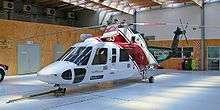Northland Emergency Services Trust


The Northland Emergency Services Trust (NEST) is a charitable trust established to provide a dedicated emergency rescue helicopter service for the people of Northland. The Trust is supported by the generous contributions made by local sponsors, individuals, families, businesses and organisations.
A Board of Trustees governs NEST and oversees its strategic direction and management.
All NEST trustees are Northlanders. NEST understands the difficulties faced with unsealed roads, Northland's changeable weather and the fact that the community is spread over a wide area that’s often difficult to access quickly by road. NEST is also aware of the increased risk of death and serious injury caused when medical treatment is delayed – all of which makes Northland’s Rescue Helicopter service so essential.
History
The Northland Emergency Services Trust, often abbreviated NEST, based in Whangarei, New Zealand. The idea for the Northland Emergency Services Trust was conceived at a public meeting called at the request of the Auckland Surf Club in 1988. The meeting discussed the idea of having a rescue helicopter in Northland for three months over the summer period.
Joyce Ryan, who was Whangarei’s mayor at the time, asked those present if they thought the money that was being asked for, to run the service for three months, seemed fair. After discussion, the St John contingent said: “We can do the same job for the same money, but for the whole year.”
While costs exceeded those envisaged in 1988, NEST believes its service has far exceeded Northlanders’ expectations. It transported its first patient on Tuesday 15 November 1988, and has since carried more than 16,000 in 25 years to safety.
In 1988, when NEST began, its emergency helicopter was a Bell 206 – which is a basic single pilot, one engine and one patient rescue helicopter. The Bell Jet Ranger is the most popular helicopter ever built with over 6000 flying worldwide. It also has one of the best safety records of any helicopter on the market, which made it the perfect choice for NEST when we started.
In 1991, the Bell Jet Ranger was replaced with a more powerful Eurocopter Squirrel emergency helicopter and in 1994 the Squirrel was replaced with a twin-engine MBB/Kawasaki BK 117.
In 1997, the first Sikorsky S-76 emergency helicopter joined our fleet and today we can rely on our three Sikorsky helicopters to service the needs of Northland.
When the people of Northland decided to set up a rescue helicopter service back in 1988, they aimed to provide one that was wholly community-owned and supported. NEST has achieved this and aims to retain its foundations within the community it serves. It also intends to continue to provide the people of Northland with an excellent, safe, effective and efficient service, and will do so by maintaining its present course – one of providing first class flight crews aboard top class aircraft.
Helicopters
It currently operates 3 Sikorsky S-76 helicopters (known as Helimed-1, Helimed-2 and Helimed-3) in Search and Rescue, Medevac, and Hospital transfer roles from its base at St John's ambulance centre, adjacent to Kensington Park. There have been several helicopter upgrades since the formation of NEST in 1988, including a Bell 206B Jetranger, a Eurocopter Squirrel, and a MBB/Kawasaki BK 117.
The Northland Rescue Helicopter has a longer range (3hrs 10mins standard or 5hrs 30mins with spare tank fitted), is faster (155 knots) and has more room inside than any other rescue helicopter in New Zealand. Its operational range covers a radius of 270km from its base, making it suitable for all of Northland, extending south beyond Auckland, and off shore work. The helicopters are set up to allow two pilots, 2 patients on horizontal stretchers and four medical support staff to occupy the cabin comfortably.
Fundraising
Funds for NEST are collected through annual appeals, sponsored by Northpower and Top Energy (covering marketing of the campaign), which ensures that each dollar donated goes directly to the helicopter.
External links
- NEST Homepage (official website, including some of the latest callouts attended)
- NEST Youtube Page